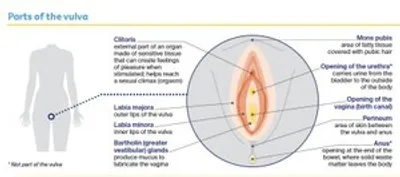The vulva
The vulva is a general term for a female’s external sexual organs (genitals). The main parts of the vulva are shown in the diagram below.
What is vulvar cancer?
Vulvar cancer is the abnormal growth of cells in any part of the vulva. It is also called vulval cancer or cancer of the vulva.
It most commonly develops in the skin of the labia majora, labia minora and the perineum. Less often, it involves the clitoris, mons pubis or Bartholin glands. As the cancer grows, it can spread to areas near the vulva, such as the vagina, bladder or anus.
Normally, cells multiply and die in an orderly way, so that each new cell replaces one lost. Sometimes cells become abnormal and keep growing. These abnormal cells may form a lump called a tumour. If the cells in a tumour are cancerous, they can spread through the bloodstream or lymph vessels and form another tumour at a new site. This new tumour is known as secondary cancer or metastasis.
Answers to some other key questions are below.
How common is vulvar cancer?
Vulvar cancer is rare – about 420 women are diagnosed each year in Australia. It is more likely to affect women who have gone through menopause (stopped having periods), but it can occur at any age.
Anyone with a vulva can get vulvar cancer – women, transgender men, non-binary people and intersex people. For more information, speak to your doctor or see our ‘LGBTQI+ People and Cancer’ booklet.
What are the main types of vulvar cancer?
The types of vulvar cancer are named after the cells they start in.
Squamous cell carcinoma (SCC)
- starts in thin, flat (squamous) skin cells covering the surface of the vulva
- most common type (about 9 out of 10 cases)
- verrucous carcinoma is a rare subtype that looks like a large wart and grows slowly
Vulvar (mucosal) melanoma
- starts in skin cells (melanocytes) found in the lining of the vulva
- less than 1 out of 10 cases
There are also rarer types of vulvar cancer. These include sarcomas, adenocarcinomas, Paget disease of the vulva, and basal cell carcinomas (BCCs).
What are precancerous vulvar cell changes?
Sometimes the squamous cells in the vulva start to change. These changes may be precancerous. This means there is an area of abnormal tissue (a lesion) in the vulva that is not cancer, but may develop into cancer over time if left untreated.
These lesions are called vulvar squamous intraepithelial lesions (SIL). They can be classified as:
- low grade (LSIL), which may go away without treatment and is linked to human papillomavirus (HPV)
- high grade (HSIL), which may develop into vulvar cancer and is linked to HPV
- differentiated vulvar intraepithelial neoplasia (dVIN), which may develop into vulvar cancer and is not usually linked with HPV but is linked with the skin condition lichen sclerosus.
Most cases of vulvar SIL don’t develop into vulvar cancer. Your doctor will explain the treatment options suitable for you.
What are the risk factors?
Vulvar squamous intraepithelial lesions (SIL) – Having vulvar SIL increases the risk of developing vulvar cancer. This condition changes the vulvar skin, and may cause itching, burning or soreness.
Human papillomavirus (HPV) – Many cases of vulvar cancer are caused by infection with HPV, which is a very common virus in people who are sexually active. HPV often causes no symptoms. Only some types of HPV cause cancer, and most people with HPV don’t develop vulvar or any other type of cancer. It can be many years between infection with HPV and the first signs of high grade squamous intraepithelial lesions (HSIL) or vulvar cancer.
Other risk factors – These include:
- the skin conditions vulvar lichen planus, vulvar lichen sclerosus or extramammary Paget disease
- having had an abnormal cervical screening test or cancer of the cervix or vagina
- smoking tobacco (which can make cancer more likely to develop in people with HPV)
- being aged over 70 (a little over half of all vulvar cancers are in women over 70)
- having a weakened immune system.
What are the symptoms?
Early vulvar cancer often has no obvious symptoms. It is commonly diagnosed after having vulvar symptoms for months or years. These may include:
- an ulcer that won’t heal
- a lump, sore, swelling or wart-like growth
- itching, burning and soreness or pain in the vulva
- thickened, raised skin patches (may be red, white or dark brown)
- a mole on the vulva that changes shape or colour
- blood, pus or other discharge coming from an area of skin or a sore spot in the vulva (not related to your menstrual period)
- hard or swollen lymph nodes in the groin area.
Many women don’t look at their vulva, so they don’t know what is normal for them. The vulva can be difficult to see without a mirror, and you may feel uncomfortable examining your genitals. If you feel any pain in your genital area or notice any of these symptoms, visit your general practitioner (GP) so they can examine the area you are concerned about. Don’t let embarrassment stop you getting checked.
How is vulvar cancer diagnosed?
Physical examination
Your doctor will look at the vulva and examine your groin and pelvic area. They may also insert an instrument with smooth, curved sides (speculum) into your vagina, so the doctor can check the vagina and cervix for cancer.
Cervical screening test
This test looks for cancer-causing types of HPV in a sample of cells taken from the cervix or vagina. During the physical examination, the doctor uses a small brush or swab to remove some cells from the surface of the cervix. This test replaced the Pap test in 2017.
Colposcopy
This uses a magnifying instrument called a colposcope to look at the vulva, vagina and cervix. The colposcope is placed near your vulva but does not enter your body.
Biopsy
During a colposcopy, your doctor will usually take a small tissue sample (biopsy) from the vulvar area and possibly the vaginal area. A biopsy may be done under local anaesthetic, which numbs the area, or general anaesthetic, which sends you to sleep. Your doctor will explain how much bleeding to expect afterwards and how to care for the wound. A biopsy is the best way to diagnose vulvar cancer. The tissue sample will be sent to a laboratory for testing.
Imaging scans
Staging vulvar cancer
If vulvar cancer is found, you may have one or more imaging scans to check if it has spread. These may include a chest x-ray, CT or MRI scan of the pelvis, or PET–CT scan.
To find out more about these scans, call Cancer Council 13 11 20.
Staging describes the size of the cancer and how far it has spread. Knowing the stage helps doctors recommend the best treatment for you.


